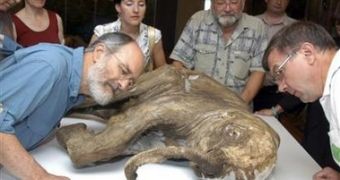In May 2007, a baby mammoth found in the Russian permafrost represented the best preserved mammoth ever found (and even the best preserved prehistoric animal). The animal looked like it had just died, missing only its hair.
The 37,000-year-old female specimen was baptized "Lyuba" after the wife of reindeer breeder and hunter Yuri Khudi, who discovered it in Russia's Arctic Yamalo-Nenetsk region. Lyuba is weighing 50 kg (110 lb), is 85 cm tall and measures 130 cm from trunk to tail, about the size of a large dog.
Now, the Russian scientists have announced they got the most detailed images so far of the inner organs of a mammoth. The mammoth was returned from Japan to Russia in February, where it was investigated using computer tomography.
"We could see for the first time how internal organs are located inside a mammoth. Her internal organs were well preserved - the heart was seen distinctly with all its ventricles and atria, as well as the liver and its veins," lead researcher Alexei Tikhonov, deputy director of the Russian Academy of Science's Zoological Institute, told Reuters.
The analyses revealed Lyuba had eaten milk and was 3 to 4 months old when it died. Because its skin was intact, its internal organs were protected from degradation by modern-day microbes.
"The computer tomography revealed no injuries or fractures," said Tikhonov.
It also appeared that Lyuba's airways and digestive system were clogged with silt, thus the baby mammoth had drowned.
"If we take samples of Lyuba's tissues by biopsy, without unfreezing her, there is a big chance we can obtain promising results in genetics and microbiology. I believe the genetic map (of the mammoth) will be decoded within a year or two. As for (Lyuba's) practical use, we will have discovered methods of decoding the genetic map of any extinct prehistoric animals. There were species that died out during the human era. And while I do not think someone would attempt to reproduce the mammoth, it would still make sense to bring back to life gigantic birds from Madagascar or New Zealand, or the Steller's sea cow (an extinct mammal), and so on and so forth," said Tikhonov.
Lyuba is stored in a purpose-built container that keeps sub-zero temperatures to impede the decay of her tissues. Tikhonov is skeptical about cloning the mammoth.
"Cloning can only be done if whole cells are intact, but the freezing conditions will have caused the cells to burst," said Tikhonov.

 14 DAY TRIAL //
14 DAY TRIAL //